by Judy Gonyeau, managing editor
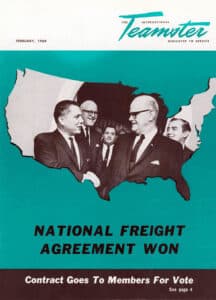
The cover story for the February 1964 issue of The International Teamster was all about the Master Freight Agreement, setting the Teamsters on a forward path to a National contract and political power that went beyond anything they thought could be attained.
The Teamsters Master Freight Agreement
1964: The Year of the Ford Mustang

GM Bison Concept Turbine Truck
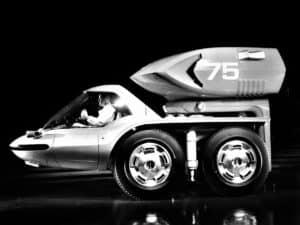
NEW YORK WORLDS FAIR – General Motors introduced the newly designed Bison concept truck at the New York World’s Fair. Featuring a tilt-forward canopy, four-wheel steering, and a GT-309 turbine power plant that sat above and behind the cockpit, this aerodynamic design was meant to haul a new one-size-fits-all mobile container. This was four years before a world-wide standard for shipping containers was adopted. The turbines could reach 280-720hp. GM had a vision that trucks of the future could offer automatic unloading and loading trailers to make this type of work easier for businesses. – motorcities.org
The Civil Rights Act is Signed
JULY 2 – President Lyndon B. Johnson signed the Civil Rights Act into law at a White House ceremony. The Civil Rights Act of 1964 hastened the end of legal Jim Crow. It secured African Americans equal access to restaurants, transportation, and other public facilities. It enabled blacks, women, and other minorities to break down barriers in the workplace.
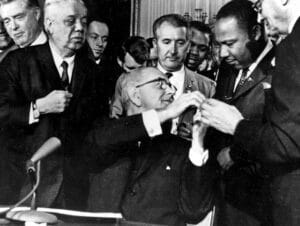
Dr. Martin Luther King Jr. after presenting the
civil rights leader with one of the 72 pens
used to sign the Civil Rights Act.
Title VI of the 1964 Civil Rights Act prohibits discrimination against racial or ethnic groups (so-called “protected classes”) by any federal financial recipient and is enforced by U.S. Department of Transportation (DOT) civil rights regulations which provides that “[n]o person or group of persons shall be discriminated against with regard to the routing, scheduling, or quality of service of transportation service furnished as a part of the project on the basis of race, color, or national origin. Frequency of service, age, and quality of vehicles assigned to routes, quality of stations serving different routes, and location of routes may not be determined on the basis of race, color, or national origin.”
The MBTA is Now Official
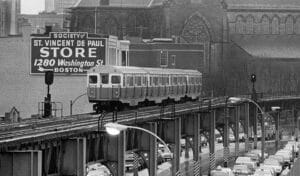
AUGUST 3 – Mid-century living in the city of Boston was becoming more congested and difficult on workers trying to get to work as the city grew and the number of cars on the roads increased. Legislators, community leaders, and urban planners conducted a massive study of transit needs in eastern Massachusetts. The result integrated the existing railroads of greater Boston into one comprehensive public transit system: The Massachusetts Bay Transportation Authority (MBTA). The MBTA, or the “T,” was voted into law on August 3, 1964, becoming the first combined regional transit system in the U.S., serving 78 municipalities in the Greater Boston area. Like the MTA, the MBTA was formed as a state agency. Construction, and now maintenance continue to plague the agency, but Bostonians have become accustomed to changes over time, and the “T” has become a thing of folk legends including the missing “Charlie” who may continue to ride the rails to this day.
Urban Mass Transportation Act Signed
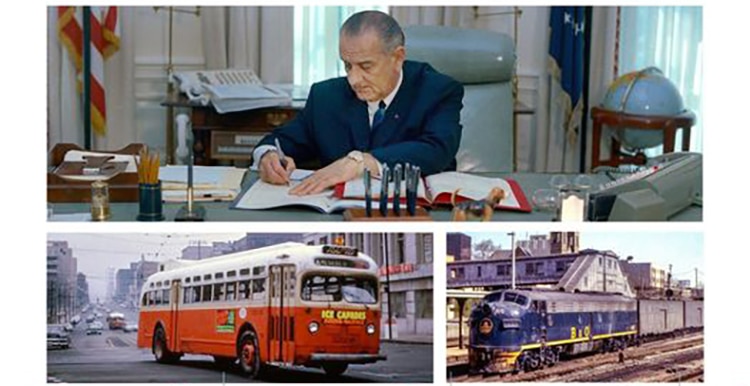
private sectors to achieve the prudent progress that Americans deserve and that they expect.”
– LBJ on the Urban Mass Transportation Act
JULY 9 – President Lyndon B. Johnson signed into law the Urban Mass Transportation Act of 1964, a three-year program granting federal matching funds to help the states and localities provide adequate mass transportation for the nation’s cities. The act provided $375 million in matching funds for large-scale urban public or private rail projects. As a result, the Urban Mass Transportation Administration (now the Federal Transit Administration) was created. Also, the act contained a provision to encourage U.S. government funds to be spent on U.S.-made products.
The Hess Trucks are (Finally) Here!
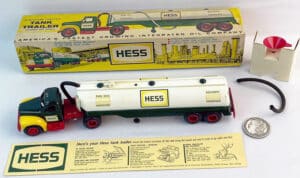
DECEMBER – The very first collectible Hess truck arrived at gas stations only a few days before Christmas, 1964. The vision for a Hess Toy Truck became a reality with the 1964 Hess Tanker Trailer. A replica of the company’s first B61 Mack truck and trailer, the toy’s features were rare for its time: working headlights and taillights controlled by a switch at the back of the cab, and a cargo tank that could be filled and emptied with an accompanying funnel and rubber hose. There were no TV ads or major radio campaigns for the Hess Tanker Trailer – just a few small newspaper ads for a well-made toy, battery included, sold at Hess gas stations.


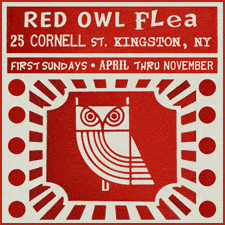


Related posts: